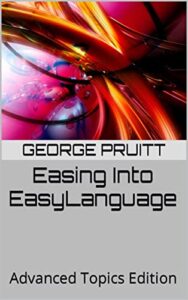All the unnecessary lines of the Python System Back-Testing Module have been hidden. Only the lines that you need to develop the next great algorithm are included. Reads sort of like English. This snippet introduces you to the use of functions and lists – two major components of the Python language. If you buy my latest book – “The Ultimate Algorithmic Trading System Toolbox” then simply email me or sign up through the contact form and you will get version 2.0 for free!
Macintosh version of Excel System Back-Tester Available
It was recently brought to my attention that the Excel System Back-Tester(ESB) did not function properly on the MAC OS X. In other words it bombed when trying to open a comma delimited data file and also when one tried to run an algorithm. Thanks to a purchaser of the UATSTB I was able to fix the bugs without removing any functionality. I will post the Macintosh version here as well as have WILEY put it on the book’s website. Sorry for any inconvenience this may have caused. Here is the the link:
Turtle Volatility Loss in Python Back Tester – Part 3 in Series
The Turtle N or Volatility is basically a 20-day Average True Range in terms of Dollars. This amount is considered the market volatility. In other words the market, based on the average, can either move up or down by this amount. It can move much less or much further; this is just an estimate. If the market moves 2 N against a position, then as a Turtle you were to liquidate your stake in that commodity. The logic indicates that if the market has a break out and then moves 2 N in the opposite direction, then the break out has failed. First the code must be defined to represent the market volatility. This is simple enough by using the sAverage function call and passing it the trueRanges and 20 days. There’s no use in converting this to dollars because what we want is a price offset. Once a position is entered the turtleN is either added to the price [short position] or subtracted from the price [long position] to determine the respective stop levels. Look at lines 2, 8 and 17 to see how this is handled. An additional trade code block must be added to facilitate this stop. Lines 17 to 28 takes care of exiting a long position when the market moves 2 N in the opposite direction. This new stop is in addition to the highest/lowest high/low stops for the past 10 -20 days.
Turtle (Last Trade Was A Loser (LTL)) Filter – Part 2 in Series
How many of you believe if the last trade was a winner, the probability of the next trade being a loser is higher? The Turtles believed this and in this post I introduce the concept of filtering trades based on the prior trade’s success.
Here is a list of trades without the filter:
20090506 Turt20Buy 1 91.75000 0.00 0.00
20090622 Long10-Liq 1 103.14000 11290.00 11290.00
20090702 Turt20Shrt 1 102.26000 0.00 0.00
20090721 Shrt10-Liq 1 100.80000 1360.00 12650.00
20090803 Turt20Buy 1 104.61000 0.00 0.00
20090817 Long10-Liq 1 101.99000 -2720.00 9930.00
20090824 Turt20Buy 1 107.71000 0.00 0.00
20090902 Long10-Liq 1 100.97000 -6840.00 3090.00
20090902 Turt20Shrt 1 100.10000 0.00 0.00
20090917 Shrt10-Liq 1 105.87000 -5870.00 -2780.00
20090924 Turt20Shrt 1 100.02000 0.00 0.00
20091008 Shrt10-Liq 1 104.72000 -4800.00 -7580.00
20091012 Turt20Buy 1 106.13000 0.00 0.00
20091030 Long10-Liq 1 109.43000 3200.00 -4380.00
20091113 Turt20Shrt 1 108.95000 0.00 0.00
20091223 Shrt10-Liq 1 106.03000 2820.00 -1560.00And here are the trades with filter engaged:
20090506 Turt20Buy 1 91.75000 0.00 0.00
20090622 Long10-Liq 1 103.14000 11290.00 11290.00
20090824 Turt20Buy 1 107.71000 0.00 0.00
20090902 Long10-Liq 1 100.97000 -6840.00 4450.00
20090902 Turt20Shrt 1 100.10000 0.00 0.00
20090917 Shrt10-Liq 1 105.87000 -5870.00 -1420.00
20090924 Turt20Shrt 1 100.02000 0.00 0.00
20091008 Shrt10-Liq 1 104.72000 -4800.00 -6220.00
20091012 Turt20Buy 1 106.13000 0.00 0.00
20091030 Long10-Liq 1 109.43000 3200.00 -3020.00
20100126 Turt20Shrt 1 104.09000 0.00 0.00
20100218 Shrt10-Liq 1 108.12000 -4130.00 -7150.00
20100219 Turt20Buy 1 109.37000 0.00 0.00
20100322 Long10-Liq 1 108.96000 -510.00 -7660.00Check for yourself – you will notice that a trade after a winner is skipped. Trades are not picked back up until a loser is reported. Trading like this is quite easy but backtesting is quite a bit more difficult. I talk about this in the book where you have to switch between actual trading and simulated trading. The beauty of the Python BackTester is that it is somewhat easy to incorporate this into the testing logic. All you have to do is determine if the prior real or simulated trade is a loser. If it isn’t then you still must keep track of all trades, but don’t book the trades that follow the winner. I have created a testing module that does just that. Here is a snippet of the code:
I will include this in an update to the Python backtester for registered users of this site.
Implementing Turtle Algorithm into the Python Backtester
I include the Python Backtester in my latest book “The Ultimate Algorithmic Trading System Toolbox” book. A good tutorial on how to use it would be to program the Turtle Algorithm in three different parts. Here is part 1:
Entry Description: Buy on stop at highest high of last twenty days. Short on lowest low of last twenty days.
Exit Description: Exit long on stop at lowest low of last ten days. Exit short on highest high of past ten days.
Position Sizing: Risk 2% of simulated 100K account on each trade. Calculate market risk by utilizing the ten day ATR. Size(shares or contracts) = $2,000/ATR in dollars.
Python code to input into the backtester:
This snippet only contains the necessary code to use in the Python Backtester – it is not in its entirety.
This algorithm utilizes a fixed fractional approach to position sizing. Two percent or $2000 is allocated on each trade and perceived market risk is calculated by the ten-day average true range (ATR.) So if we risk $2000 and market risk is $1000 then 2 contracts are traded. In Part 2, I will introduce the N risk stop and the LAST TRADE LOSER Filter.
Using Quandl Data
If you haven’t come across the great data resource Quandl.com I highly suggest in doing so. A portion of the data that I used in writing my latest book came from Quandl, specifically the wiki futures or CHRIS database. Here is the link:
https://www.quandl.com/data/CHRIS
There is a ton of free futures data. The different contracts are concatenated into large files. However, the rollover discount is not taken into consideration so the data “as-is” is somewhat un – testable. I am in the process of scrubbing the data as well as creating a “Panama” adjustment to the contracts in the large files. As soon as I complete this task I will provide the data on this website. Purchasers of my latest book will find 10+ plus years of history of continuous futures data that I pieced together from several different sources, including Quandl.
Creating Custom Symbol List in Portfolio Maestro
Here is a quick video that shows how to create a custom symbol list in TradeStation’s Portfolio Maestro. I describe this in my new book, “The Ultimate Algorithmic Trading System Toolbox.” The books should be released in May.
Quick Video On Creating Symbol List with Portfolio Maestro
Further Clarification on Data Aliasing
[follow_me]I was speaking with Mike Chalek on the phone this weekend concerning Data Aliasing and he felt this post was a little confusing. After re-reading it I can see where he is coming from. Using the same example let me see if I can clarify: assume the trading day is Wednesday and you want to keep track of the slope of a 19-day weighted moving average of data2 (weekly bars) by using a variable. The following code will give an erroneous result:
wAvg = wAverage(c of data2,19);
mySlope = wAvg – wAvg[1];
If you interrogate mySlope intra-week then it will always be equal to zero. The wAvg is by default tied to data1 which in this case is daily bars. So the value of wAvg is carried over from one day to the next. It only changes when the average of the weekly bar changes and that only occurs on Friday.
There are two possible solutions:
Without the use of data aliasing – inLine function calls
mySlope = wAverage(c of data2,19) – wAverage(c[1] of data2,19) ;
With the use of data aliasing –
vars: wAvg(close of data2,0);
wAvg = wAverage(c of data2,19);
mySlop = wAvg – wAvg[1];
Either examples will work, but if you have several variables tied to a different data stream, then the code will be much cleaner looking using data aliasing – plus it cuts down on multiple function calls.
Using Multiple Time Frames in a Strategy
I have been working on a project where the strategy combined daily and weekly bars. Keeping track of the two time frames was, at one time, not that easy. However, with TradeStation’s Data Aliasing it is no problem at all. We all know that Data 1 is the highest resolution time frame and is the one used for trade execution. Data 2 can be a different market or a different time from of the same market. TradeStation allows for multiple data streams. Take a look at the following output in table 1. Wavg is a nine period moving average of weekly crude data. Wavg[1] is the prior value of the moving average. If you wanted to make a trading decision on a daily bar basis by looking at the slope of the Wavg you couldn’t. The Wavg and Wavg[1] only changes at the beginning of the next week. Most traders want to be able to make a trading decision intra-week by examining the current values of the Davg1, Davg2 and the slope of Wavg. During the week the slope of Wavg is ZERO.
table 1
Date Davg1 Davg2 Wavg Wavg[1]
1151019 46.94 46.38 46.17 46.17
1151020 47.01 46.54 46.17 46.17
1151021 47.00 46.69 46.17 46.17
1151022 46.95 46.74 46.17 46.17
1151023 46.93 46.70 46.54 46.17<< changed here
1151026 46.83 46.55 46.54 46.54
1151027 46.71 46.47 46.54 46.54
1151028 46.74 46.44 46.54 46.54
1151029 46.74 46.40 46.54 46.54
1151030 46.73 46.39 46.60 46.54
1151102 46.57 46.37 46.60 46.60
1151103 46.55 46.45 46.60 46.60
1151104 46.36 46.44 46.60 46.60
Now look at table 2. The Wavg is not being updated on a daily basis but on a weekly basis. The current Wavg doesn’t become the prior Wavg on each daily bar. Wavg[1] stays the same until a new weekly bar occurs. You can now make a trading decision intra-week by examining the slope of the Wavg. Each time frame update should only occur when a new bar of that same time frame is generated. This feature is really cool and is easy to implement.
table2
Date Davg1 Davg2 Wavg Wavg[1]
1151019 46.94 46.38 46.17 45.75 < notice how the Wavg and Wavg[1] are always different
1151020 47.01 46.54 46.17 45.75
1151021 47.00 46.69 46.17 45.75
1151022 46.95 46.74 46.17 45.75
1151023 46.93 46.70 46.54 46.17
1151026 46.83 46.55 46.54 46.17
1151027 46.71 46.47 46.54 46.17
1151028 46.74 46.44 46.54 46.17
1151029 46.74 46.40 46.54 46.17
1151030 46.73 46.39 46.60 46.54
1151102 46.57 46.37 46.60 46.54
1151103 46.55 46.45 46.60 46.54
1151104 46.36 46.44 46.60 46.54
Here is the code that utilizes Data Aliasing. All I did was declare the weekly avg variable and tied it to data2.
vars: mavShortDaily(0),mavLongDaily(0);
vars: mavWeekly(0,data2);
mavShortDaily = average(c,19);
mavLongDaily = average(c,39);
mavWeekly = average(C of data2, 9);
If mavShortDaily > mavLongDaily and mavWeekly > mavWeekly[1] then buy this bar on close;
If mavShortDaily < mavLongDaily and mavWeekly < mavWeekly[1] then sellshort this bar on close;
print(date," ",mavShortDaily," ",mavLongDaily," ",mavWeekly," ",mavWeekly[1]);Notice how the variable mavWeekly was tied to data2. When you delcare a variable that is tied to another data other than data1 you can put the data stream right in the variable delcaration : mavWeekly(0,data2).







